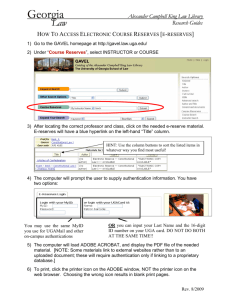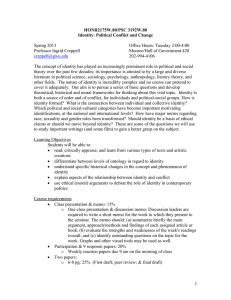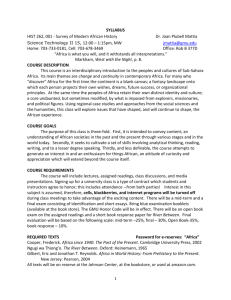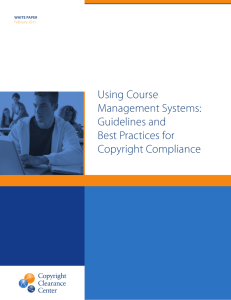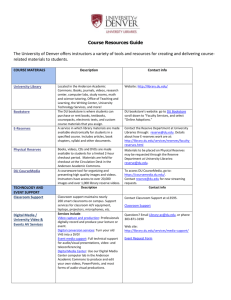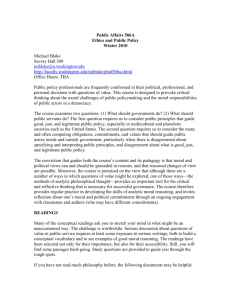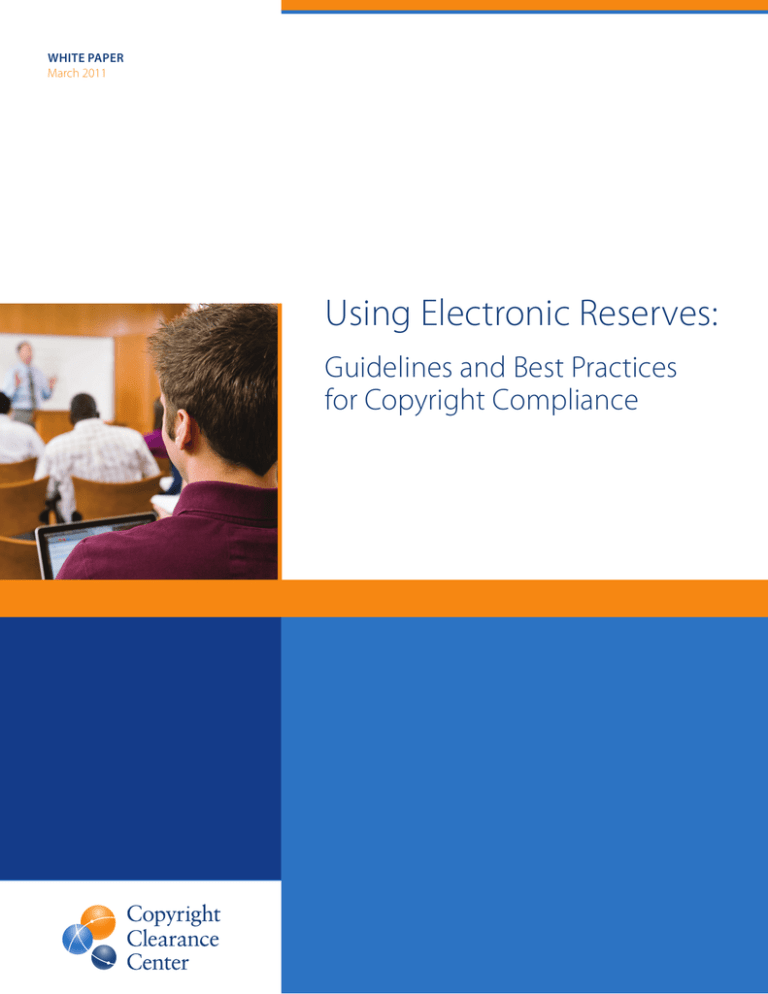
WHITE PAPER
March 2011
Using Electronic Reserves:
Guidelines and Best Practices
for Copyright Compliance
WHITE PAPER
Using Electronic Reserves:
Guidelines and Best Practices
for Copyright Compliance
The movement to electronic reserves
Many institutions are quickly adopting electronic methods for sharing reserve content
with students. These “e-reserves” — ranging from electronically scanned paper
documents to other content that originates in electronic format (such as online journal
articles) — are typically made available to students through an academic department
Web site, a course management system or a library network. These systems usually
require password authentication and enable students to electronically download and
locally print the reserve material.
Best practices and guidelines for using e-reserves
It is important for librarians, instructors, and students to remember that, from a copyright
law perspective, there is no distinction between paper reserves and e-reserves. The same
fair use guidelines apply to e-reserves; if the particular use of content doesn’t meet the
fair use criteria in hard copy form, it is unlikely to be considered fair use in digitized form.
The following principles summarize key guidelines and encapsulate examples of best
practices followed by many academic institutions regarding their e-reserves.
• Online doesn’t mean “free” – Widespread use of the Internet has fostered
misconceptions concerning the lawful use of copyrighted information in electronic
form. However, the same copyright rules apply — simply because content is online
does not mean it is free from copyright protection. Make sure you have permission
before posting content.
• Limit e-reserve materials to small excerpts – Most experts advise using a single
article or chapter, or less, of a copyrighted work, but even brief excerpts must be
viewed in the overall context of other readings offered for a course. If the total effect
is to create a compilation or “digital coursepack” of unlicensed materials, the case
for treating individual excerpts as fair use is significantly weakened and permission
should be sought.
• E-reserves require the same permissions as coursepacks – While there are
obvious savings — financial and environmental — from eliminating paper copies
of reserves or coursepacks, traditional copyright rules still apply when using digital
technology such as e-reserves: the institution must obtain permission from the
rightsholder or its agent, who may charge a fee for such permission based on the
amount of material and number of people viewing the material (i.e. students).
01
WHITE PAPER
Using Electronic Reserves:
Guidelines and Best Practices
for Copyright Compliance
• E-reserves are not a substitute for the purchase of textbooks (or coursepacks)
– It violates the intent, spirit, and letter of the law to use e-reserves as a substitute for
the purchase of books, subscriptions, or other materials when substantial portions of
the material are required for educational purposes.
• “First semester free” – The “first use is free” standard invoked by many libraries is not
part of the Copyright Act or any subsequent rulings or agreed-upon guidelines. Any
content posted in an e-reserve channel always requires copyright permission, unless
it is covered by fair use, public domain, or other exception.
• Get permission before posting – Unlike inter-library loans, you need to secure
copyright permissions prior to posting content. Reposting of the same material for
use in a subsequent semester requires a new permission.
• Passwords are a good start – Restricting access to e-reserves through passwords or
other authentication measures is a helpful, good-faith practice because rightsholders
typically grant permission and charge fees based on the number of students enrolled
in a course. In fact, these types of protections may make rightsholders more likely to
grant permission, since they are stricter control mechanisms than controls for paper
reserves. However, by itself, the use of authentication measures such as passwords is
not enough to satisfy the fair use standard and permission is still required prior to use
of the content.
• Know what you’ve paid for – Reuse rights included in subscriptions vary greatly
by publisher. Be sure to check your license’s terms and conditions to determine if
the rightsholder has granted you permission to post the copyrighted work in an
e-reserves forum.That can alleviate the need to request permission and ensure you
don’t pay twice for posting rights you already hold.
• Work from authorized originals – When scanning in paper materials (such as
textbooks) to create e-reserve copies, libraries should be sure that they are working
from original, licensed copies of the works—either purchased or owned by the
institution or instructor.
• Remove expired e-reserves promptly – Make sure you take down (or remove
access to) copyrighted e-reserve content for a particular class when the term
concludes.
• Include copyright notices – Materials on e-reserve should contain both the
copyright notice from, and a complete citation to, the original material as well as a
clear caution against further electronic distribution.
02
WHITE PAPER
Using Electronic Reserves:
Guidelines and Best Practices
for Copyright Compliance
The best way to secure copyright permissions
for your e-reserves
About Copyright Clearance Center
Representing copyright holders from
around the world, Copyright Clearance
Center (CCC) is a global rights broker
for millions of the world’s most sought
after content, including in- and out-ofprint books, e-books, journals, blogs,
newspapers, magazines and images.
Started in 1978, CCC creates
innovative licensing solutions that
help businesses get permission to use
copyright-protected materials while
compensating authors, publishers and
other content creators for the use of
their works. CCC serves organizations
of all types and sizes, including 400
of the Fortune 500 companies, and
licenses more than 20 million content
users in over 180 countries.
You can obtain permission to use copyrighted content for your e-reserves in the same
way that you would for paper reserves or printed coursepacks. Let the rightsholder or
its agent know what material you want to use, in which course, for how long, and how
many students will have access to it. The rightsholder will decide whether to grant
permission and what price to charge for the material you are seeking to share with
students.
Copyright Clearance Center provides academic institutions — including librarians,
faculty and staff, administrators, print services, and campus bookstores — with the most
convenient way to get permission from thousands of rightsholders to share information
with students, colleagues, alumni, the media, and more.
For online permission to use content from thousands of rightsholders for a variety of
needs including e-reserves, library reserves, interlibrary loan, document delivery, print
and electronic course packs, classroom handouts, distance education, and administrative
uses, visit copyright.com.
For more information about Copyright Clearance Center’s compliance solutions, please
visit copyright.com, e-mail info@copyright.com, or call 978-750-8400.
© 2011 Copyright Clearance Center, Inc.
All rights reserved. Copyright Clearance Center and
the Copyright Clearance Center logo are registered
trademarks of Copyright Clearance Center, Inc.
222 Rosewood Drive
Danvers, MA 01923 USA
+1.978.750.8400 Phone
+1.978.646.8600 Fax
info@copyright.com
www.copyright.com
ACA0311

